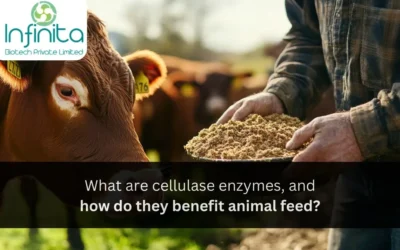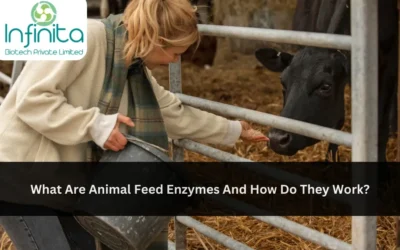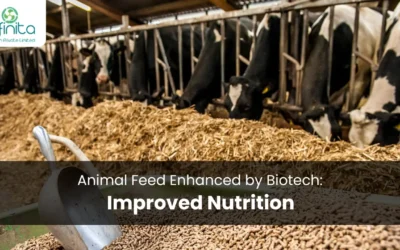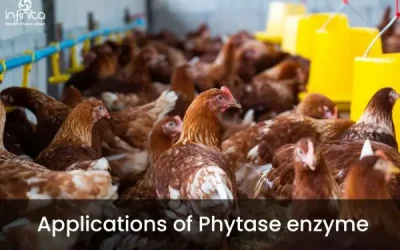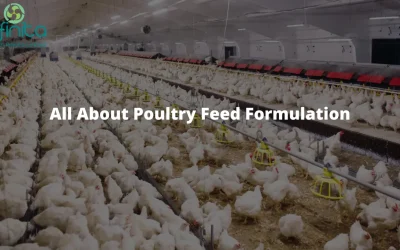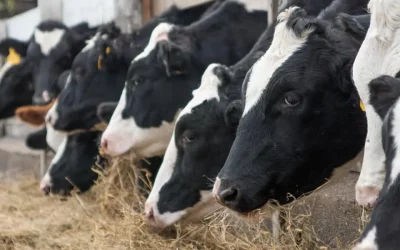Animal feed enzymes play a crucial role in improving the overall nutritional quality of animal feeds. These enzymes, which are derived from various sources, have a significant impact on animal health and the environment. In this article, we will delve into the basics of animal feed enzymes, their role in animal nutrition, the impact they have on animal health, and the environmental implications of their use. We will also explore the future of animal feed enzymes, including technological advances and potential challenges.
Understanding the Basics of Animal Feed Enzymes
Animal feed enzymes are natural proteins that accelerate biochemical reactions in the digestive system of animals. They promote the breakdown of complex feed components into simpler, more digestible forms. Enzymes like amylases, proteases, and lipases are commonly used in animal feed to enhance digestion and nutrient absorption. These enzymes are typically added to feed formulations in precise amounts to target specific feed ingredients and improve nutrient utilization.
The Role of Enzymes in Animal Nutrition
Enzymes play a crucial role in animal nutrition by increasing the availability of essential nutrients for optimal growth and development. They help break down complex carbohydrates, proteins, and lipids present in feed ingredients, making them more accessible to the animal’s digestive system. This enhanced digestibility leads to better nutrient absorption and utilization, resulting in improved animal performance and overall health.
Different Types of Feed Enzymes
There are various types of feed enzymes used in animal nutrition, each targeting specific feed components. Amylases, for example, break down starch into simpler sugars, while proteases break down proteins into amino acids. Lipases, on the other hand, assist in the digestion of fats. Additionally, phytases are used to improve phosphorus utilization by breaking down phytate, a form of phosphorus that is not readily available to animals.
Another important type of feed enzyme is cellulase, which aids in the digestion of cellulose, a complex carbohydrate found in plant cell walls. Cellulose is abundant in many feed ingredients, such as hay and grass, but it is indigestible by most animals. By adding cellulase to animal feed, the cellulose can be broken down into simpler sugars, which can then be easily digested and utilized by the animal.
In recent years, there has been growing interest in the use of feed enzymes derived from microbial sources. These enzymes are produced by microorganisms such as bacteria and fungi, and they offer several advantages over traditional enzymes. Microbial enzymes tend to be more stable and effective in a wider range of pH and temperature conditions, making them suitable for various animal production systems. Furthermore, they can be produced in large quantities through fermentation processes, ensuring a sustainable and reliable source of enzymes for animal feed.
The Impact of Feed Enzymes on Animal Health
The use of feed enzymes has a profound impact on animal health by improving digestibility and nutrient absorption. By breaking down complex feed components, enzymes enable animals to extract maximum nutritional benefits from their feed. This enhanced nutrient utilization leads to improved growth rates, optimal body condition, and reduced incidence of digestive disorders.
Furthermore, the application of feed enzymes in animal diets has been shown to have environmental benefits. Enhanced digestibility means that animals excrete fewer undigested nutrients, resulting in reduced nutrient excretion into the environment. This, in turn, helps to minimize the environmental impact of animal agriculture and promotes sustainable farming practices.
Enhancing Digestibility with Enzymes
Enzymes, such as amylases, proteases, and lipases, play a vital role in enhancing the digestibility of carbohydrates, proteins, and fats. This increased digestibility allows animals to extract more energy from their feed, supporting their metabolic processes and overall health. Additionally, improved digestibility reduces the risk of undigested feed components reaching the lower gut, minimizing the chance of digestive disturbances.
Moreover, the use of feed enzymes can lead to economic benefits for livestock producers. By improving nutrient utilization and feed efficiency, enzymes help reduce feed costs and improve the overall profitability of animal production operations. This cost-effectiveness makes feed enzymes a valuable tool for enhancing animal health while maintaining economic viability in the livestock industry.
Boosting Immune System Function
Feed enzymes can also have a positive impact on the immune system of animals. As animals absorb nutrients more efficiently, their immune system becomes better equipped to defend against diseases and infections. This improved immune function contributes to overall animal well-being and reduces the need for therapeutic interventions, such as antibiotics.
Overall, the incorporation of feed enzymes into animal diets represents a multifaceted approach to promoting animal health, environmental sustainability, and economic efficiency in livestock production systems. By optimizing nutrient utilization, enhancing immune function, and reducing environmental impact, feed enzymes play a crucial role in supporting the well-being of animals and the success of agricultural operations.
Environmental Implications of Animal Feed Enzymes
The use of animal feed enzymes also brings about positive environmental implications. By improving nutrient utilization, these enzymes help reduce the overall environmental impact of animal production systems.
Animal feed enzymes play a crucial role in enhancing the sustainability of livestock farming practices. Through their ability to break down complex feed components into simpler forms, enzymes enable animals to digest their food more efficiently. This increased efficiency not only benefits the animals’ health and growth but also has significant environmental advantages.
Reducing Greenhouse Gas Emissions
Enzymes aid in breaking down complex feed components into simpler forms, allowing animals to digest them more efficiently. This increased efficiency results in reduced nutrient excretion and, subsequently, reduced greenhouse gas emissions such as methane, which is a potent contributor to climate change. By reducing the environmental footprint of animal production systems, feed enzymes contribute to sustainable agriculture.
Reducing greenhouse gas emissions is a critical aspect of combating climate change, and the role of animal feed enzymes in this process cannot be overstated. By optimizing nutrient utilization and digestion in livestock, enzymes help minimize the release of methane and other harmful gases into the atmosphere. This not only benefits the environment but also aligns with global efforts to mitigate the impact of agriculture on climate change.
Minimizing Waste and Improving Sustainability
The enhanced digestibility provided by feed enzymes reduces the amount of undigested feed and nutrients excreted in animal waste. This not only minimizes environmental pollution but also improves the sustainability of animal production systems. Moreover, the efficient use of feed ingredients translates into better resource management, as less feed is required to achieve desired production outcomes.
Efforts to minimize waste and improve sustainability in livestock farming are essential for long-term environmental health. By incorporating feed enzymes into animal diets, farmers can enhance the efficiency of nutrient utilization, reduce waste production, and promote more sustainable agricultural practices. This holistic approach benefits both the animals and the environment, paving the way for a more environmentally conscious and efficient livestock industry.
The Future of Animal Feed Enzymes
The future of animal feed enzymes holds great promise, with ongoing research and technological advancements driving innovation in enzyme production.
Animal feed enzymes have revolutionized the way we approach animal nutrition, offering a sustainable and efficient solution to enhancing feed quality. These enzymes play a crucial role in breaking down complex nutrients, such as proteins, carbohydrates, and fats, into simpler forms that are more easily absorbed by animals. This not only improves nutrient utilization and overall animal health but also reduces the environmental impact of animal production systems by minimizing waste production.
Technological Advances in Enzyme Production
Researchers are exploring novel techniques to improve enzyme production and increase enzyme efficacy. This includes optimizing enzyme formulations, exploring new enzyme sources, and developing enzyme delivery systems to enhance stability and bioavailability. These technological advances aim to further improve the performance and cost-effectiveness of feed enzymes.
One exciting area of research involves the use of genetic engineering to enhance enzyme production in microbial hosts. By genetically modifying microorganisms to overproduce specific enzymes, researchers can create more efficient and cost-effective enzyme production processes. This cutting-edge approach not only increases enzyme yields but also allows for the customization of enzymes to target specific substrates, maximizing their effectiveness in animal feed applications.
Potential Challenges and Solutions in Feed Enzyme Use
While feed enzymes offer significant benefits, challenges related to enzyme stability, cost, and compatibility with different feed ingredients still exist. However, ongoing research aims to address these challenges through improved enzyme formulations, enzyme immobilization techniques, and advancements in enzyme production technologies. By overcoming these challenges, the full potential of feed enzymes can be realized.
Enzyme immobilization, a process that involves fixing enzymes onto a solid support material, is gaining traction as a solution to enhance enzyme stability and reusability in feed applications. Immobilized enzymes exhibit greater resistance to harsh environmental conditions and can be easily separated from the feed mixture, allowing for multiple cycles of enzyme use. This approach not only reduces enzyme wastage but also improves the overall cost-effectiveness of enzyme supplementation in animal feed.
In conclusion, animal feed enzymes play a critical role in animal nutrition by improving nutrient utilization, enhancing animal health, and reducing the environmental impact of animal production systems. As advancements continue to unfold, the future of feed enzymes appears promising, paving the way for more efficient and sustainable animal feed formulations.

